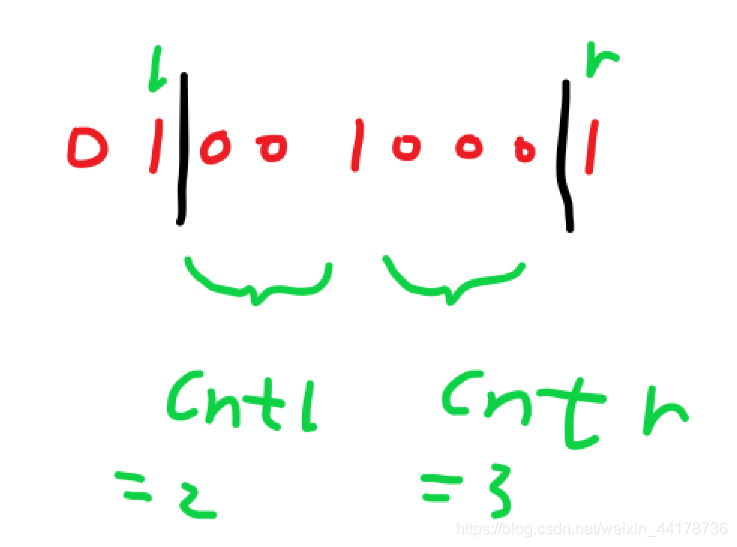LeetCode 1573. 分割字符串的方案数(组合数学)
本文共 1231 字,大约阅读时间需要 4 分钟。
题意:
给你一个二进制串 s (一个只包含 0 和 1 的字符串),我们可以将 s 分割成 3 个 非空 字符串 s1, s2, s3 (s1 + s2 + s3 = s)。请你返回分割 s 的方案数,满足 s1,s2 和 s3 中字符 '1' 的数目相同。由于答案可能很大,请将它对 10^9 + 7 取余后返回。数据范围:s[i] == '0' 或者 s[i] == '1'3 <= s.length <= 10^5
解法:
设tot为1的总数量,如果tot=0,那么答案为C(n-1,2),如果tot!=0,那么:设串下标为[1,n],找到满足s[1,l]=tot/3的最小下标l,找到满足s[r,n]=tot/3的最大下标r,然后统计l+1开始到其右边第一个1之间0的数量cntl,以及r-1开始到其左边第一个1之间0的数量cntr.那么答案为(cntl+1)*(cntr+1),因为左边有cntl+1个空隙可以选择,右边有cntr+1个空隙可以选择.如下图:

code:
class Solution { public: static const int maxm=1e5+5; static const int mod=1e9+7; int d[maxm]; int numWays(string s) { memset(d,0,sizeof d); int n=s.size(); s='p'+s; int ans=0; for(int i=1;i<=n;i++){ d[i]=d[i-1]+(s[i]=='1'); } int tot=d[n]; if(tot==0){ return 1ll*(n-1)*(n-2)/2%mod; } if(tot%3)return 0; int l=1; while(d[l]!=tot/3)l++; int r=n; while(d[n]-d[r-1]!=tot/3)r--; int cntl=0,cntr=0; for(int i=l+1;i<=n;i++){ if(s[i]=='0')cntl++; else break; } for(int i=r-1;i>=1;i--){ if(s[i]=='0')cntr++; else break; } return 1ll*(cntl+1)*(cntr+1)%mod; }}; 转载地址:http://igkv.baihongyu.com/
你可能感兴趣的文章
Nginx 的优化思路,并解析网站防盗链
查看>>
Nginx 的配置文件中的 keepalive 介绍
查看>>
nginx 禁止以ip形式访问服务器
查看>>
Nginx 结合 consul 实现动态负载均衡
查看>>
Nginx 负载均衡与权重配置解析
查看>>
Nginx 负载均衡详解
查看>>
nginx 配置 单页面应用的解决方案
查看>>
nginx 配置https(一)—— 自签名证书
查看>>
nginx 配置~~~本身就是一个静态资源的服务器
查看>>
Nginx 配置服务器文件上传与下载
查看>>
Nginx 配置清单(一篇够用)
查看>>
Nginx 配置解析:从基础到高级应用指南
查看>>
Nginx 集成Zipkin服务链路追踪
查看>>
nginx 集群配置方式 静态文件处理
查看>>
nginx+php的搭建
查看>>
nginx+tomcat+memcached
查看>>
Nginx+Tomcat实现动静分离
查看>>
nginx+Tomcat性能监控
查看>>
nginx+uwsgi+django
查看>>
nginx+vsftp搭建图片服务器
查看>>